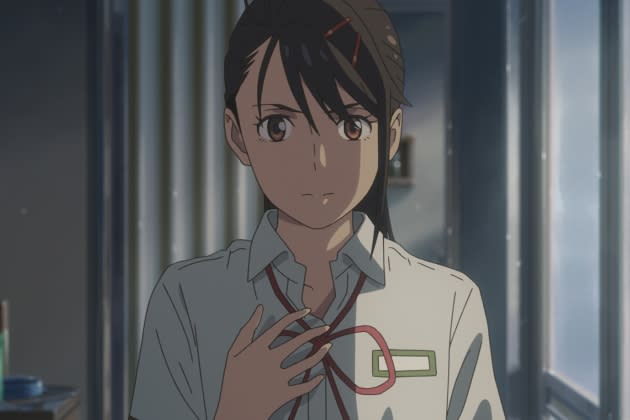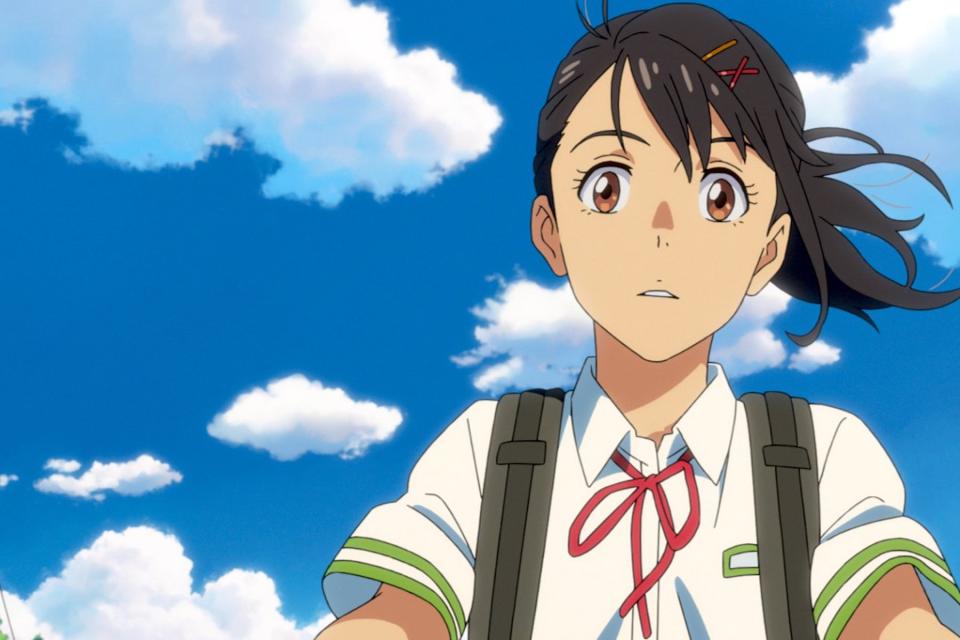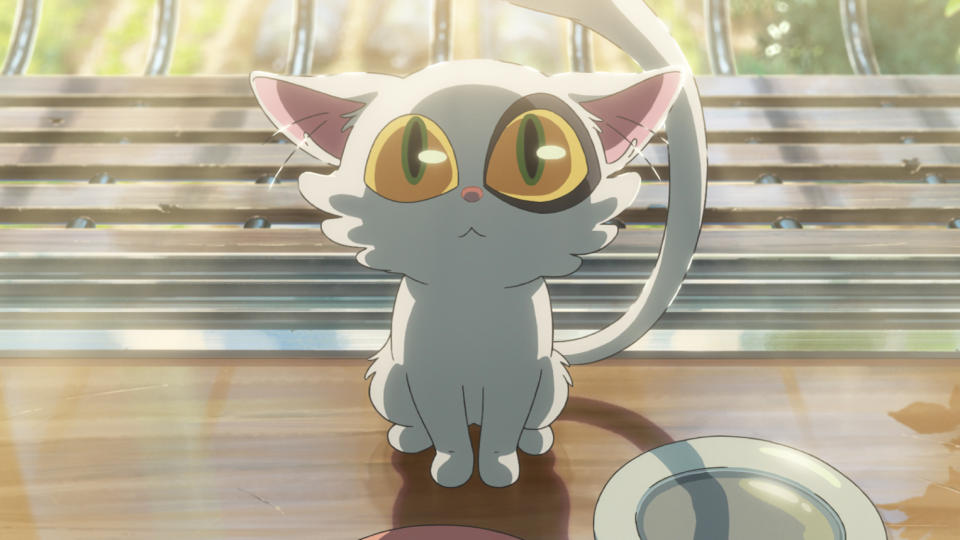The Beauty of ‘Suzume’: A Stunning Anime Epic About Grieving Tragedy
- Oops!Something went wrong.Please try again later.

Hollywood doesn’t make movies like Suzume, anime auteur Makoto Shinkai’s latest, about a teen girl who traverses Japan to prevent a series of natural disasters. We get stories about young people saving the world all of the time, sure, but the protagonists are usually dressed in spandex rather than school uniforms, and — even when the stakes are similarly cataclysmic — there is usually a bad guy to punch at the end. In Suzume, there are no bad guys for our eponymous schoolgirl-on-the-lam to take out. There is only the wonder and terror of the natural world, and the unfathomable losses we are asked to live past in the face of it.
“I feel a lot of what nature does isn’t something that humans can stop or affect,” Shinkai tells Rolling Stone, through an interpreter. “It’s more about our relationship in terms of how we live side by side, or how we coexist with what nature throws at us.”
More from Rolling Stone
'The Super Mario Bros. Movie' Is Not Ruined by Chris Pratt's Mario
Netflix's 'My Dad the Bounty Hunter' Is an Afrofuturist Marvel
It’s a rich, universal, and humbling theme, and one the Japanese filmmaker has explored to great success before. In 2016, Shinkai’s Your Name broke box office records with its story of a body-swapping teen romance threatened by an inevitable natural disaster. In 2019, Shinkai’s Weathering with You gave us the story of a girl who can control the weather, and the boy who falls in love with her. And now, when Suzume hits U.S. theaters on April 14, Shinkai imagines a supernatural explanation for the earthquakes that frequent Japan: massive earthworms, or mimizu, that live in a mythological world beneath ours.
Shinkai specializes in crafting these kinds of fairy-tale premises that nonetheless stay rooted in a recognizable reality, perhaps because the animator treats the quiet, slice-of-life elements of his films just as seriously as he does the big fantasy moments. Shinkai uses real locations and props to craft the vivid details of his anime worlds, and then fills them with characters doing the kinds of recognizable tasks that often get left out of live-action fantasy. Characters send texts and post on social media. They make lunch, and catch ferries. Birds fly high in the sky, and rain moves like shadows over the city pavement. This commitment to rendering the mundanities of contemporary life so magically makes the moments when Shinkai characters do the impossible — like fall through an infinite sky, or ride a shadowy earthworm down to the ground — feel like they could be part of our world, too. In Shinkai films, the mundane and fantastical meet in the artfully constructed middle, creating a space somewhere between dreamscape and reality where big, teenage emotions can thrive.

It helps that Shinkai’s main characters are usually just learning about the world’s fantasy elements too. The film opens with Suzume as a small child, wandering alone through a desolate, beautiful other-world where boats sit atop houses, searching for her mother. But that’s getting ahead of the emotional mystery at the core of Shinkai’s story, and not something Suzume herself understands until the film’s emotional climax. When the story properly begins, Suzume (Nanoka Hara) is a 17-year-old, living with her aunt on the southern island of Kyushu, and ignorant to the existence of the mimizu. One day, while Suzume is on her way to school, a mysterious (read: hot) boy named Souta (Hokuto Matsumura) asks for directions to the local ruins, where one of the doorways to the mimizu’s world resides. Souta is a “closer,” someone who is tasked with keeping the doors between worlds closed and locked. If the doors are left open, the mimizu will escape, causing disaster. When Suzume accidentally removes one of the two “keystones” guarding these doors (and gets Souta turned into a walking, talking yellow chair in the process), she sets out on an adventure to set things right. It isn’t going to be easy, however. Not only is Souta a chair, but the keystone Suzume unleashed has transformed into an adorable talking cat named Daijin (Ann Yamane), who is now living his best, most Instagram-worthy life, apparently unmoved by the disasters popping up in his wake.
Your Name and Weathering with You were both inspired by the 2011 Tōhoku earthquake and tsunami that killed almost 20,000 people — a tragedy that lingers understandably large in the Japanese public consciousness. However, Suzume is the first of Shinkai’s films to make the connection to the Great East Japan Earthquake explicit by bringing it into a character’s backstory. “It wasn’t my intent to necessarily showcase the earthquake or the disaster,” says Shinkai, noting that Suzume began with the desire to make a cross-country adventure film. “However, as I tried to depict Japan in its current state and to create an adventure movie… I always came face to face or collided with the 2011 incident.”
Suzume truly is a road trip movie. The characters begin in the southwest corner of Japan, in Kyushu island’s Miyazaki, before traveling to Ehime, through Tokushima and Kobe, from Tokyo to Miyagi, and eventually to Tōhoku. Shinkai says he was inspired to make a road trip movie while talking to audiences for screenings of his previous films. “[Fans] wanted to see their own hometown and their own experience expressed and depicted through animation,” says Shinkai. “So simply by turning this into a road trip film, I think I’ve answered a lot of those voices in one film.”
As Suzume and Souta follow Daijin’s social media trail across the country, they must rely on the kindness of strangers to move, shelter, and feed them. (Well, Souta the Chair doesn’t eat…) The people Suzume meets on her trip are kind, even when they ask something of her — perhaps especially when they ask something of her, welcoming her into their worlds by giving her responsibility for it in the form of babysitting duty or a work shift at a karaoke bar. At first glance, these character-driven detours may seem like a distraction from the main event. Really,
they elevate Suzume from an entertaining but relatively predictable romantic-fantasy adventure to something greater: an exploration of tragedy past the individual.
In the U.S., we have plenty of stories about individual loss, but we rarely tell stories driven explicitly by collective mourning. In Suzume, the doorways that lead to the world of the mimizu are in forgotten theme parks and abandoned towns, in places that were once loud with the living, but now lie lonely. “I couldn’t really come face to face with that theme, without showing Japan in its entirety,” says Shinkai. “Of course, the earthquake itself happened in the Tōhoku region, but it didn’t just affect them. It affected us collectively as a country… Showing the earth, the soil, and the wind of each different area was important to really come face to face with that central theme.”
In Suzume, there are many kinds of mourning, tied to the many kinds of irretrievable, often intertwined loss — of a person, a time, a tradition, a home. When Souta is instructing Suzume how to lock a door, he tells her, “Close your eyes and think of all of the people who lived here. Think of the emotion that should be here.” It’s that prioritization of deep emotional catharsis — for the characters, and for the audience — that sets much of Shinkai’s work (and the larger anime tradition) apart from Hollywood’s more plot-driven blockbusters.

If you’ve ever watched a Makoto Shinkai film, then you’ve probably cried at the end of a Makoto Shinkai film, generously helped along by rock band Radwimps’ musical accompaniment. Shinkai says his stories are not designed to provoke specific emotional responses in viewers — mostly because it is an unachievable goal. “Having produced and made movies for 20 years,” says Shinkai, “what I can’t say and what I do feel is that it’s really hard to attempt to control an audience’s emotions or to try to evoke certain reactions… My part is to provoke thoughts. And if I can’t get the exact reaction that I’m looking for, that’s OK. And you know, I have to come to terms with that because I think it’s impossible to do. So I see my role as more of a guide as opposed to a manipulator.”
Hollywood doesn’t make movies like Suzume. I don’t know if we are culturally equipped to, so untrained are we as a society to stop and grieve even our most obvious wounds, our deepest losses. But, like nature, grief is not something that you can ignore. It will come for you, as it does for Suzume and the viewer at the conclusion of this story’s road trip. Grief is not something Suzume can simply defeat, like a bad guy. It’s something she has to learn to live with, to accept. That’s not a bad thing. Or, even if it is, the alternative is worse: a life of forgetting the things that have mattered to us, as both individuals and societies.
Prior to Suzume’s release in Japan last year, Shinkai held a screening of the film in Tōhoku, the region devastated by the 2011 earthquake and tsunami. “Most of the audience that came to my specific screening where I did a stage greeting were very thankful that I made the film about this huge tragedy and incident that’s on the brink of being forgotten,” says Shinkai. “They were appreciative that we put the spotlight on it once again. Or perhaps, through the film, they heard the words that they really wanted to or needed to hear.”
Best of Rolling Stone

